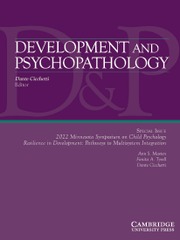Crossref Citations
This article has been cited by the following publications. This list is generated based on data provided by
Crossref.
Ben-David, Vered
Jonson-Reid, Melissa
Bright, Charlotte
and
Drake, Brett
2016.
Family formation: A positive outcome for vulnerable young women?.
Children and Youth Services Review,
Vol. 67,
Issue. ,
p.
57.
Sheikh, Mashhood A.
Abelsen, Birgit
and
Olsen, Jan A.
2016.
Clarifying Associations between Childhood Adversity, Social Support, Behavioral Factors, and Mental Health, Health, and Well-Being in Adulthood: A Population-Based Study.
Frontiers in Psychology,
Vol. 7,
Issue. ,
Salokangas, Raimo K. R.
Schultze-Lutter, Frauke
Patterson, Paul
von Reventlow, Heinrich Graf
Heinimaa, Markus
From, Tiina
Luutonen, Sinikka
Hankala, Juha
Kotimäki, Mika
and
Tuominen, Lauri
2016.
Psychometric properties of the Trauma and Distress Scale, TADS, in an adult community sample in Finland.
European Journal of Psychotraumatology,
Vol. 7,
Issue. 1,
Fletcher, Shelley
Elklit, Ask
Shevlin, Mark
and
Armour, Cherie
2017.
Predicting Time Spent in Treatment in a Sample of Danish Survivors of Child Sexual Abuse.
Journal of Child Sexual Abuse,
Vol. 26,
Issue. 5,
p.
535.
Widom, Cathy Spatz
2017.
Long-Term Impact of Childhood Abuse and Neglect on Crime and Violence.
Clinical Psychology: Science and Practice,
Vol. 24,
Issue. 2,
p.
186.
Clément, Marie-Ève
Bérubé, Annie
and
Moreau, Jacques
2017.
Le modèle de la pédiatrie sociale en communauté et ses retombées sur le bien-être des familles : une étude pilote.
Revue internationale de l'éducation familiale,
Vol. n° 39,
Issue. 1,
p.
81.
January, Stacy-Ann A.
Mason, W. Alex
Savolainen, Jukka
Solomon, Starr
Chmelka, Mary B.
Miettunen, Jouko
Veijola, Juha
Moilanen, Irma
Taanila, Anja
and
Järvelin, Marjo-Riitta
2017.
Longitudinal Pathways from Cumulative Contextual Risk at Birth
to School Functioning in Adolescence: Analysis of Mediation Effects
and Gender Moderation.
Journal of Youth and Adolescence,
Vol. 46,
Issue. 1,
p.
180.
Patwardhan, Irina
Hurley, Kristin Duppong
Thompson, Ronald W.
Mason, Walter A.
and
Ringle, Jay L.
2017.
Child maltreatment as a function of cumulative family risk: Findings from the intensive family preservation program.
Child Abuse & Neglect,
Vol. 70,
Issue. ,
p.
92.
Patwardhan, Irina
Mason, W. Alex
Savolainen, Jukka
Chmelka, Mary B.
Miettunen, Jouko
and
Järvelin, Marjo‐Riitta
2017.
Childhood cumulative contextual risk and depression diagnosis among young adults: The mediating roles of adolescent alcohol use and perceived social support.
Journal of Adolescence,
Vol. 60,
Issue. 1,
p.
16.
Parra, Gilbert R.
Smith, Gail L.
Mason, W. Alex
Savolainen, Jukka
Chmelka, Mary B.
Miettunen, Jouko
and
Järvelin, Marjo‐Riitta
2017.
Tests of linear and nonlinear relations between cumulative contextual risk at birth and psychosocial problems during adolescence.
Journal of Adolescence,
Vol. 60,
Issue. 1,
p.
64.
Ahnert, Lieselotte
Teufl, Lukas
Ruiz, Nina
Piskernik, Bernhard
Supper, Barbara
Remiorz, Silke
Gesing, Alexander
and
Nowacki, Katja
2017.
FATHER–CHILD PLAY DURING THE PRESCHOOL YEARS AND CHILD INTERNALIZING BEHAVIORS: BETWEEN ROBUSTNESS AND VULNERABILITY.
Infant Mental Health Journal,
Vol. 38,
Issue. 6,
p.
743.
Brumley, Lauren D.
Jaffee, Sara R.
and
Brumley, Benjamin P.
2017.
Pathways from Childhood Adversity to Problem Behaviors in Young Adulthood: The Mediating Role of Adolescents’ Future Expectations.
Journal of Youth and Adolescence,
Vol. 46,
Issue. 1,
p.
1.
Baams, Laura
2018.
Disparities for LGBTQ and Gender Nonconforming Adolescents.
Pediatrics,
Vol. 141,
Issue. 5,
Hébert, Martine
Langevin, Rachel
and
Oussaïd, Essaïd
2018.
Cumulative childhood trauma, emotion regulation, dissociation, and behavior problems in school-aged sexual abuse victims.
Journal of Affective Disorders,
Vol. 225,
Issue. ,
p.
306.
Kerig, Patricia K.
2018.
Polyvictimization and Girls’ Involvement in the Juvenile Justice System: Investigating Gender-Differentiated Patterns of Risk, Recidivism, and Resilience.
Journal of Interpersonal Violence,
Vol. 33,
Issue. 5,
p.
789.
Spinazzola, Joseph
van der Kolk, Bessel
and
Ford, Julian D.
2018.
When Nowhere Is Safe: Interpersonal Trauma and Attachment Adversity as Antecedents of Posttraumatic Stress Disorder and Developmental Trauma Disorder.
Journal of Traumatic Stress,
Vol. 31,
Issue. 5,
p.
631.
Ford, Julian D.
and
Delker, Brianna C.
2018.
Polyvictimization in childhood and its adverse impacts across the lifespan: Introduction to the special issue.
Journal of Trauma & Dissociation,
Vol. 19,
Issue. 3,
p.
275.
Windle, Michael
Haardörfer, Regine
Getachew, Beth
Shah, Jean
Payne, Jackie
Pillai, Dina
and
Berg, Carla J.
2018.
A multivariate analysis of adverse childhood experiences and health behaviors and outcomes among college students.
Journal of American College Health,
Vol. 66,
Issue. 4,
p.
246.
Widom, Cathy Spatz
Czaja, Sally J.
Kozakowski, Sandra Sepulveda
and
Chauhan, Preeti
2018.
Does adult attachment style mediate the relationship between childhood maltreatment and mental and physical health outcomes?.
Child Abuse & Neglect,
Vol. 76,
Issue. ,
p.
533.
Islam, Md. Jahirul
Mazerolle, Paul
Broidy, Lisa
and
Baird, Kathleen
2018.
Does the type of maltreatment matter? Assessing the individual and combined effects of multiple forms of childhood maltreatment on exclusive breastfeeding behavior.
Child Abuse & Neglect,
Vol. 86,
Issue. ,
p.
290.




